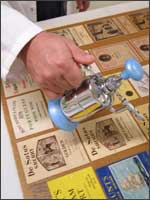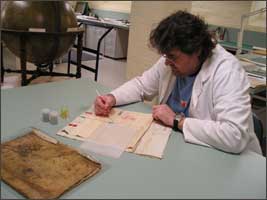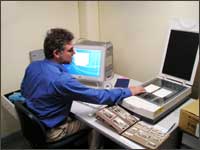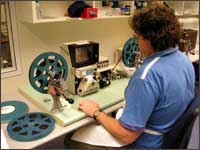
Preservation
Preserving our cultural heritage
 Behind each digitised resource presented in SA Memory is a story about the preservation of the original item.
Behind each digitised resource presented in SA Memory is a story about the preservation of the original item.
Some of these stories are simply told. A Centennial exhibition poster from the 1930s may need a small tear repaired and the protection of a polypropylene sleeve.
Others, such as the 1836 Deed of Settlement of the South Australian Company, have received hours of specialist treatment by a professional conservator.
All have had digital copies made to scanning standards that preserve the details of the original as well as enabling the production of the web surrogate file that you view in SA Memory.
The State Library's Preservation Team
The Preservation team has overall responsibility for preserving and protecting the State Library's archival and published heritage collections for the benefit of current and future generations.
Preservation is a broad umbrella term and its scope wide-ranging. It includes conservation - the detailed treatment of individual items - as well as broader strategies for protecting and housing collections, and producing surrogate copies such as microforms and photographs.
The team faces the daily challenge of preserving information in diverse forms from paper and parchment to photographs, moving pictures, sound recordings, videos, CDs, DVDs, diskettes and items that originate purely in a digital format.
Conservation
The Conservation staff provide specialised treatments for individual collection items. Conservation treatments include carefully flattening heavily creased old documents, repairing leather binding, and building special supports and boxes to fit fragile items and mounting items for exhibitions.
 The Conservation team plays a key role in:
The Conservation team plays a key role in:
- conducting collection surveys to identify preservation needs
- monitoring environmental conditions in collection storage areas
- implementing integrated pest management strategies
- preparing, installing and condition monitoring of exhibition items
- coordinating the library's response to any disaster that may affect the collections
- delivering education programs on preservation awareness
The team works closely with Artlab Australia. Specialising in conservation services, Artlab provides the more complex treatments for State Library materials, including those featured in exhibitions.
Artlab also conducts professional development training for Library staff.
Reformatting
Reformatting, the copying of information from one format to another, is another strategy that ensures the long-term preservation of the State Library's published and archival heritage collections.
Materials are reformatted to preserve the fragile originals, while copies or surrogates are created for use. For example, microfilm and digital copies may be created and the original materials stored securely.
 The Reformatting team uses a range of technologies to produce reformatting products and services that meet national and international standards, including:
The Reformatting team uses a range of technologies to produce reformatting products and services that meet national and international standards, including:
- microforms
- digitisation
- photography
- sound recordings
Members of the team also organise the outsourcing of various reformatting services, such as the production of preservation film or video copies from original motion pictures.
Microfilming is internationally regarded as one of the best long-term preservation strategies with a life expectancy of up to 500 years. In the future it can be easily read with the help of a simple magnifying glass. It is also possible to digitise from microfilm.
In comparison digital information is transient as a result of rapid changes in software and hardware. Examples include videodisks and eight inch floppy disks which are now museum pieces. This means that digital information requires an investment of frequent updates to ensure its longevity.
The team's expert microfilming unit undertakes a range of state and national projects and has recently acquired a state of the art hybrid camera that digitises and microfilms in one sequence. The team has recently undertaken work for the National Library to produce microfilming training materials for the Asian Pacific Region.
 Reformatting staff also digitise key pictorial collections to provide a wider circle of users with better access to the Library's unique pictorial collections. In turn, these digital images contribute to the national collection of digital images available through Picture Australia.
Reformatting staff also digitise key pictorial collections to provide a wider circle of users with better access to the Library's unique pictorial collections. In turn, these digital images contribute to the national collection of digital images available through Picture Australia.
In the challenging field of digital preservation the Library contributes to the national PANDORA archive. Pandora is an archive of selected Australian on-line publications, such as electronic journals, organisational web sites, government publications and ephemera. The State Library is responsible for selecting and cataloguing South Australian Internet sites to preserve these websites and other South Australian digital publications.
Other reformatting strategies include conventional photography and sound recording - for example, creating use copies of oral history recordings for customers.
The Reformatting Team also provides copies of collection material for sale, such as photographs in print or digital form, and undertakes cooperative projects and 'fee-for- service' work.
Collection Maintenance
The Collection Maintenance team is responsible for providing services which relate to the everyday 'care and repair' of collections.
These services include repairing torn pages, protecting maps and posters in folders, and shrink-wrapping fragile newspapers.
The Collection Maintenance team also:
- provides collection housing such as boxes for pamphlets and sets of magazines
- manages the outsourcing of the library's book binding needs
- monitors collection use, growth, storage and repair needs
- manages reorganising and moving of collections
- coordinates searching for missing items
The Collection Maintenance team also carries out the day-to-day retrieval and reshelving that supports the State Library's information services.
Collection Storage
The State Library collections contain more than:
- 580 000 books and pamphlets
- 40 000 periodical and newspaper titles
- 360 000 photographs
- 109 000 wine labels and other ephemera
- 85 000 CDs records and other AV
- 5000 hours of oral history
- 4000 metres of archival material
The State Library's collections are stored on 50 kilometres of shelves, both in the North Terrace city buildings and off-site storage facilities in the western suburbs.
The Preservation section is responsible for ensuring that collections are located and stored efficiently and effectively according to the strategies identified in a Master Storage Plan.
These strategies include shelving common sized materials and formats together, and locating the most heavily used materials on-site, with the lesser used materials off-site.
The storage system in the redeveloped State Library in the city covers the entire basement of the Spence Building.
It incorporates a number of features to offer optimum storage conditions including:
- a compactus storage system tailored to meet specific State Library needs
- air conditioning which forces air through the compactus to prevent the development of a micro-climate
- a manually geared wheel system which moves compactus shelving. It is robust, low in maintenance, and safe and easy to use.
- specialised units designed to accommodate material in a range of formats and sizes from maps and plans, to art works, films and children's toys
- a secure Rare Books Room for rare items.
Preventative strategies
The Preservation team undertakes environmental monitoring of collection storage areas and, jointly with the Facilities team, leads the Library's integrated pest management strategies, helping to reduce the risk of pest damage to collections.
The team is also responsible for disaster preparedness and response, as well as maintaining the disaster response equipment. The most common incidents are leaks and minor flooding.
The cleaning of items is another preventative strategy, as dust and grit cause long-term damage to library collections. The Conservation team coordinates the collection cleaning program: targeting priority areas, developing procedures, liasing with contractors, and monitoring progress.
Exhibitions
Preservation staff play a key role in supporting the Library's exhibition program-both within the Library and externally.
Conservation staff are responsible for checking the condition of items prior to exhibition or loan, and flattening, repairing and stabilising items. They also prepare supports and mounts for exhibition items and lead the Library's exhibition installation team. Conservation staff also assist in monitoring the condition of exhibition items.
Reformatting staff are responsible for providing copies such as digital and conventional photographs, film clips and sound recordings, which add extra dimension to exhibitions.
Artlab Australia has worked closely with Preservation staff to provide training, and advise on preparing, mounting, installing and managing the exhibition of collection items. Artlab also undertakes specialised and more complex treatments of exhibition items such as those in the Treasures Wall.
Education
The team has a special focus on education programs to promote awareness about preservation of Library collections to staff and the general public.
These programs include tours, and sessions for special interest groups. Many of the sessions are run in partnership with Artlab Australia. Contact us on +61 8 8207 7250 for details.
Projects and publications
Projects
The Preservation team works cooperatively at a state and national level to ensure the preservation of cultural heritage.
Funded by the National Library, the team has recently completed two major co-operative projects to microfilm the South Australian newspapers SA Truth 1941-1964 and the Yorke's Peninsula Plain Dealer 1895-1926.
Current partnerships with public libraries and other organisations have facilitated the microfilming of further titles. Cooperation with Mount Gambier Public Library and the Border Watch Newspaper has enabled microfilming of the Border Watch 1985-1986. Port Adelaide/Enfield Public Library has made possible microfilming of Northern Suburbs Weekly 1952-1961 and the Northern District Courier 1925-1927.
The Reformatting team has also recently undertaken work for the National Library to produce microfilming training materials for the Asian Pacific Region.
Staff also digitise key pictorial collections to form part of the national collection of digital images available through Picture Australia.
The State Library contributes to the national PANDORA archive of selected archive of selected Australian on-line publications, such as electronic journals, organisational and government sites.
Several projects are also undertaken in line with national preservation strategies. For example, as part of the National Strategy on Cellulose Acetate, staff are working on a major project to copy all acetate microfilms onto a stable polyester film-base, rehouse them in 'archival' storage containers and relocate master copies to the National Library 's cold storage vault.
A smaller program to progressively stabilise and copy 'at-risk' acetate-based South Australiana films and videos onto professional Betacam video is continuing.
Library staff foster the discussion of professional microfilming issues through the international listserv Microlink-l jointly owned with the National Library of Australia.
Publications
- Berthon, Hilary and Fritha Jones. 'Responding to preservation microfilming training needs in the Asia/Pacific' International Preservation News no. 27, August 2002, p. 26
- 'The Portonian: a model microfilming project' Extra Extra December 2001-March 2002


